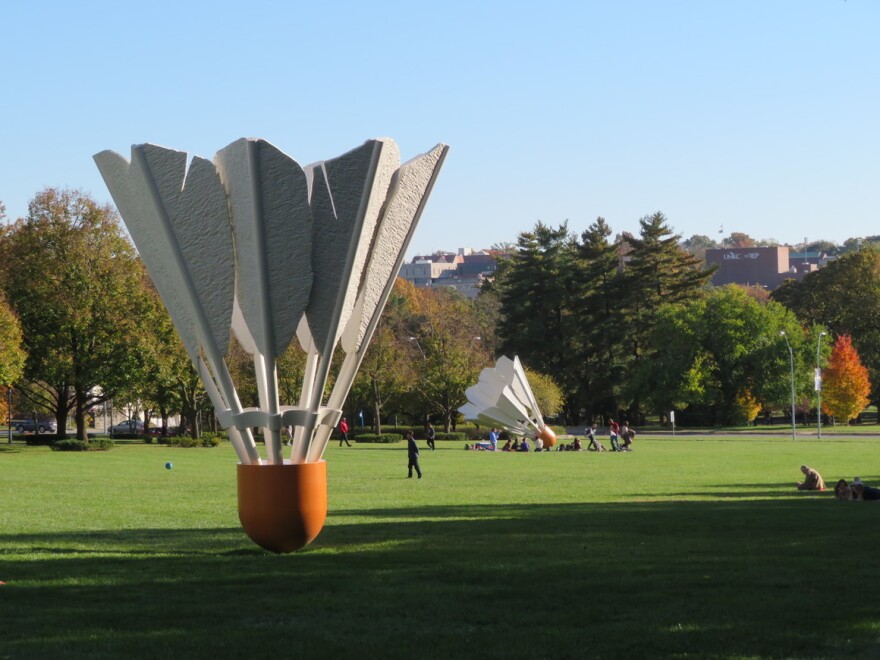This story was first published in KCUR's Creative Adventure newsletter. You can sign up to receive stories like this in your inbox every Tuesday.
Kansas City is known for a lot of things. Our fountains rival Rome’s. We’re a cradle of jazz. Our sports teams win national championships. The local barbeque culture competes with any in the nation.
But in the last 200 years, some innovations have flown under the radar. KCUR’s A People’s History of Kansas City explored the history of sliced bread, invented in 1928 in Chillicothe, Missouri, a town about 100 miles northeast of Kansas City. Each year on July 7, the town celebrates Sliced Bread Day.
Wondering about other sources of hometown pride? From inspiration to invention, record-breaking community efforts and religious relics, enjoy a few of Kansas City’s more bizarre and esoteric claims to fame.
The birthplace of an American icon

It’s unlikely that Walt Disney and Ub Iwerks imported a mouse to their short-lived Laugh-O-Gram Studios in the early 1920s, so the mouse that inspired Mickey Mouse was likely a Kansas City original.
The story goes that Disney either fed or trained a mouse while working in Kansas City. A few years later, the men were out in California and in need of a new unique character. Disney recalled that little Midwestern mouse and Iwerks drew it up — round ears, black eyes, big-buttoned short pants — just one of many characters they created on the path toward animation domination.
Disney embellished the story so much that it’s difficult to know the complete truth, but believe it or not, for a moment, the character was originally named “Mortimer.” Imagine life in the “Mortimer Mouse” Club!
Today, Mickey Mouse is a symbol of American ingenuity and youthful exuberance. Advocates in Kansas City are working to restore the old Laugh-O-Gram Studios off of 31st Street and create a museum.
You can learn more about the men and mouse with “The Battle Over Mickey Mouse” from A People's History of Kansas City.
Large and in charge

Kansas City is the largest metropolitan area in the state of Kansas and the second-largest in Missouri. But that’s not all. Kansas City boasts a handful of “largest” items, symbols of history, innovation and artistry.
Not only are the giant shuttlecocks at the Nelson-Atkins Museum of Art an icon of the museum, they are coincidentally the World’s Largest Shuttlecocks, measuring over 19 feet tall. They were created by the late Claes Oldenburg and Coosje Van Bruggen and installed in 1994, creating quite the controversy at the time.
Kansas Citians have since grown to love them, and today they're a popular photo stop for tourists and locals alike. Four shuttlecocks are scattered across the Donald J. Hall Sculpture Park, one on the north side of the building and three on the south, angled as though they just dropped to the ground during play.
Though the Pistol Social Club no longer operates down in Kansas City's historic West Bottoms, the World’s Largest Cap Gun hangs above the entrance near The Ship, a music venue and eatery. Artist Brock Venti created the sculpture, and it remains as a testament to the region’s Wild West roots and the West Bottoms’ artistic, maverick vibe.
Following World War I, Kansas City became one of the largest garment manufacturers in the world, making 25% of the clothing in the United States. That heritage was honored at the Historic Garment District Museum, part of the Kansas City Museum, but it closed in August 2024.
Nearby the museum you'll find The Needle, a sculpture designed by Dan Stevens. While not the world’s largest (that’s in New York City), it’s certainly a record holder for Missouri at 22 feet tall, and honors the nearly 4,000 women who worked in the district during its heyday.
World record holders

You may be aware that Kansas City held the record for loudest crowd roar, first achieved in October 2013 (137.5 decibels) at Arrowhead Stadium during a Chiefs game and then reaffirmed in September 2014 (142.2 decibels). Not to be outdone, the University of Kansas Jayhawks went for the loudest indoor crowd roar in February 2017 (with 130.4 decibels).
But far more unique, Kansas City holds the Guinness World Record for Largest Tuba Ensemble. In 2018, 835 musicians gathered in Municipal Stadium for the annual TubaChristmas concert, a tradition hosted by the Kansas City Symphony.
During the concert, they performed an arrangement of “Silent Night” (on tubas, sousaphones, euphoniums and baritones) for six minutes and 34 seconds, breaking the 2007 record of 502 players, more than enough to secure bragging rights for years to come.
And, as a bonus: The title of Guinness World Record for the longest snake in captivity belongs to Medusa, a 25-foot reticulated python who resides in the West Bottoms.
Biblical body part

Among the myriad examples of religious art in the Nelson-Atkins Museum of Art’s collection is a 2,000-year-old finger bone, purportedly belonging to St. John the Baptist. John was Jesus’ older cousin, and an important figure in his own right, prophesying the coming of the Messiah.
At any rate, he was beheaded around 29 AD in present-day Jordan, with his body buried in present-day Palestine. Where that head ended up is open to debate, as well, but various relics are claimed to be in Istanbul, Egypt, Bulgaria, Montenegro and Chicago. The finger bone in Kansas City, however, may well be the relic that has traveled the farthest from where John lived his days.
It’s housed in an elaborate, gilded reliquary, and was part of the Guelph Treasure, ecclesiastical items collected by the Dukes of Brunswick starting as far back as the 11th century. This vessel, called a monstrance, was documented in 1482. In 1931, the collection was displayed at the Cleveland Museum of Art and from there was purchased and added to the Nelson-Atkins’ collection.
This “holy finger” and the monstrance that houses it are currently on display in a nook near the Cloister, just off Rozzelle Court. Supposedly, touching a relic of a saint can grant miracles, but this one is well behind glass in a display case.
Eat your greens

Kansas City may be best known for barbecue and strip steak, but — believe it or not — leafy greens also helped put the area on the map.
During the 1930s, farmers in Lenexa sold vast amounts of spinach. The popularity of the Popeye cartoon made spinach trendy, high-quality soil made for prime crops, and easy access to the railway meant the produce could get to markets in Chicago and New York City.
Hence, by 1934, Lenexa became the Spinach Capital of the World.
The title has since been claimed by other towns in other states, but each year Lenexans celebrate their iron-rich heritage with a Spinach Festival. The festival takes place the Saturday after Labor Day at Sar-Ko-Par Trails Park, with a craft fair, recipe competition, live entertainment and celebrity sightings — if you count Popeye and Olive Oyl.
At the festival, you can enjoy the world’s largest spinach salad (sold in individual bowls). You can pop next door to the Legler Barn Museum, which includes a display about this slice of life and view the official recipe — which includes, among other ingredients, 150 pounds of spinach, 600 mushrooms and 100 cloves of garlic. Yum!
Want more adventures like this? Sign up for KCUR's Creative Adventure Email.









